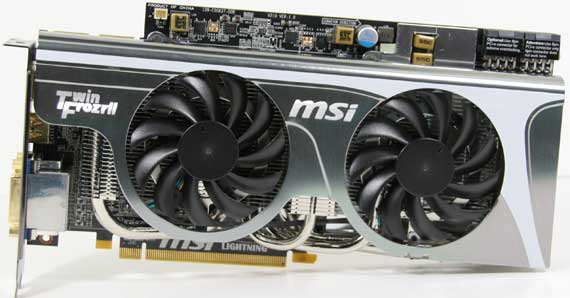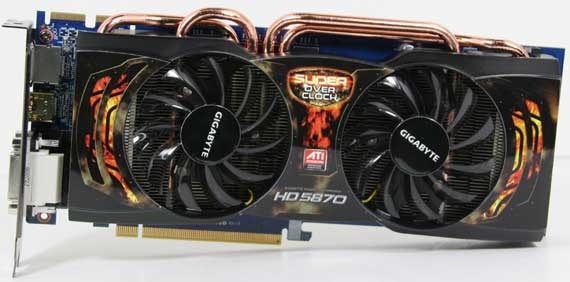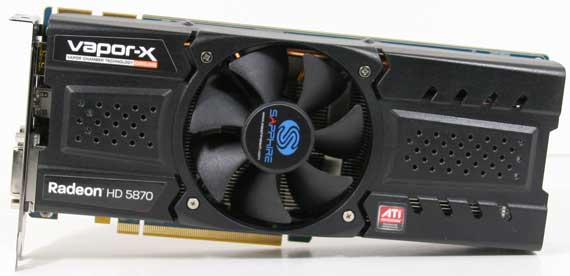Overclocked: Our Custom Radeon HD 5870 Roundup
by Ryan Smith on May 19, 2010 11:53 AM ESTConclusion
Wrapping things up, today we’ve looked at 3 different custom cards with 3 different design philosophies and 3 different sets of results.
We’ll start our conclusion with MSI’s Radeon 5870 Lighting, the purest of the overclocking specialty cards among our roundup. MSI went to bat with a design geared towards overclocking, and unfortunately they struck out. We’ll never be able to isolate just how much of this comes down to design and how much comes down to the luck of the draw for the GPU on our card, but ultimately we only got a mild overclock on top of a fairly good factory overclock.

Compared to a reference 5870 this card is a solid card, but in failing to produce an amazing overclock it’s overshadowed by our other custom cards. MSI’s Afterburner utility is a fantastic overclocking tool, but it can’t make hardware do something it’s not capable of. Perhaps with aftermarket cooling the Lightning can be a star, but anyone looking to pick one up and roll the dice on overclocking runs the risk of being as unlucky as we were. And if you’re as unlucky as us, for approximately the same price you can buy a card with a greater performance guarantee.
Next is Gigabyte’s Radeon 5870 Super Overclock, a hybrid card combining some overclocking capabilities with the highest factory overclock among our cards. As a factory overclocked card it has a very strong showing by edging out the other cards on most tests, and we believe it’s safe to call it the fastest Radeon 5870. As an overclocking card however it fails on 3 accounts: the VRMs are unable to handle higher voltages with the stock cooler, the GPU in our sample wasn’t stable even at higher voltages, and the overclocking software you have to use to control the core voltage is miserable. We can’t in good faith call this an overclocker’s card.

Even if it can’t overclock, at one point we were ready to call this the best Radeon 5870 in our roundup due to its factory overclock and cool temperatures. Then we measured the noise generated by the card and found our deal breaker – it’s entirely too loud while idling. Given that the card doesn’t have appreciably different electrical characteristics from a reference 5870 when idling, we don’t have a good reason for this card to be as loud as it is; a card doesn’t need to be that loud to dissipate 27-30W at idle. If you can stand how loud the card is at idle then it’s going to be a great choice due to its performance, temperatures, and low load noise, but we are unable to get past its high idle noise. It’s just not a good tradeoff.
This leaves us with the Sapphire Toxic 2GB, the unexpected star of our roundup. In many ways it’s an unremarkable card – it doesn’t have a dozen power phases, voltage adjustment, or voltage check points. But instead of that Sapphire focused on designing a solid card with a good factory overclock and 2GB of RAM where everyone else put 1GB, creating a fast card that manages to deliver on all of its promises and even works in a bit of end-user overclocking. It’s quieter and cooler than a reference 5870 at all times while being on average 5% faster.

It’s not quite the perfect card though as it has its share of downsides. 2GB is very forward looking, but rarely do you reap the performance benefit today while you absolutely pay the 40W-50W load power penalty for it. As a result it’s going to cost more to run and require better case ventilation than the other 5870s in our roundup. Its other downside is that outside of the cases where 2GB does help, it’s not quite as fast as the Gigabyte Radeon 5870 Super Overclock; there is a tradeoff of some performance for going with the Sapphire card. Compared to the problems that fall upon our other cards though, it's easy to see why the Sapphire Radeon 5870 Toxic 2GB is the most consistent of our cards.
Looking at the larger issues, we haven’t mentioned price too much up until now since the focus of this article is the roundup, but at $480-$500 for these cards it’s time to discuss the issue. Even when overclocked these cards are only at most 10% faster than a reference Radeon 5870 for a 20%-25% higher price. These are luxury cards that are not cost-effective, and at $500 are running right in to NVIDIA’s GeForce GTX 480.
This brings us to our final point of this roundup: looking at what an overclocked Radeon 5870 can do versus a reference clocked GTX 480. 10% is a magical number for the 5870 because 10% faster is where you need to be to start catching up to the GTX 480. At their stock clocks the Gigabyte and Sapphire cards come within 6% of the GTX 480, while overclocking reduces that to a 1-3% gap. With a good GPU, these cards can match the GTX 480 when overclocked, opening up a new avenue to buyers who want the GTX 480’s speed in games without its higher temperatures, power draw, and noise. Granted that extra RAM and overclocking splits the difference on power draw, but we’re still keeping maximum load temperatures 10W-15C below a GTX 480 and 6-8dB on load noise. At these performance levels the Gigabyte and Sapphire cards are valid alternatives to the GTX 480 and are priced competitively too. If you don’t want to spend $500 on NVIDIA’s latest and greatest, AMD’s partners have given you another path.
Long-term this also gives us an idea of where AMD would need to be with the mythical Radeon 5890 if they wanted to take the single-GPU crown back from NVIDIA. Based on our results, at around 975MHz core and 1.3GHz (5.2GHz effective) memory, we’d expect the cards to be in a dead heat. However keep in mind that this is a very big if – based on our overclocking results we find it hard to believe that AMD could get Cypress GPUs in volume that could hit 975MHz, and then there’s the matter of the memory bus. This likely isn’t something AMD can achieve without something more substantial such as a 4890-style respin, but we have certainly been caught off-guard before.










43 Comments
View All Comments
bobsmith1492 - Wednesday, May 19, 2010 - link
As an electrical engineer, I wouldn't want to buy a card that is clocked so close to it usable limit. It's just begging for premature failures, especially at such high temperatures. A few months of dust build up and these cards will be pushing 120C, typically the level where components' lifespans are drastically reduced. I hope I'm wrong but I can't see video cards pushing much more horsepower without some serious form factor modifications.The0ne - Wednesday, May 19, 2010 - link
Nope, most enthusiasts believe their system will run free of dirt and grime for years and years and temperatures will stay the same. Once a part is tainted it becomes harder and harder to have it stay cleaned :) Take CPU fan for example hahahaiamezza - Thursday, May 20, 2010 - link
Old toothbrushes work brilliantly for cleaning dusty fans and heatsinks - to a 'good as new' state ;)Folterknecht - Wednesday, May 19, 2010 - link
Hi Ryan!What BIOS did your GB HD5870 use? There are two availeble "F2" and "F3". From discussions in the german GB-Support-Forum regarding GB HD 5850 OC, which is using the same cooler as far as I can tell, new BIOS-Versions were created to deal with some issues including noise.
There have been many angry posts, because GB advertised this cooler as "SUPER SILENT"!
If your test sample used "F2" an update to "F3" and eventual changes in idle characteristics would be interesting, if the test sample is still available.
Thanks for this interesting review
Folterknecht
cactusdog - Wednesday, May 19, 2010 - link
Gigabyte cant make a decent OC card. Just like their 4870 with the one speed noisy zalman fan and no fan adjustment. They just dont get it.I had high hopes for this new 5870 version but looks like they screwed up again. Apparently they released the card with one clock mode (flat out) no 2D clocks, no UVD clocks, just max clocks. As the previous poster said ,maybe the card in this review has the original bios.
Ryan Smith - Wednesday, May 19, 2010 - link
We're using the F3 BIOS.NinjaGnome - Wednesday, May 19, 2010 - link
I wish they would offer a card that either included a waterblock or came with no heatsink at all so the user can choose a waterblock or aftermarket cooler. I dont want to pay for an expensive oc version just to throw the block away so I can throw a waterblock on it.sirizak - Wednesday, May 19, 2010 - link
Here you go: http://www.powercolor.com/us/products_features.asp...Also if you want to add aftermarket cooling I would suggest buying a reference card (with the full shroud, fan at the rear and AMD printed above the PCIe Connnector) most aftermarket cooler manufacturers are only supporting the reference design.
sirizak - Wednesday, May 19, 2010 - link
Something I think this review missed was VRM cooling on these non-reference cards, the reference HD 5870 provides superior VRM cooling compared to most non-reference cards and allows for Voltage Control. I have managed 950Mhz Core Stable on my reference card without adding any voltage.I would have loved to see some VRM temps for each card under load, and perhaps a description of the type of VRM cooling they are offering.
Other than that great review, I was tossing up about the MSI and Gigabyte when I was purchasing so I found this really interesting, if a little late for my decision making :)
Ryan Smith - Thursday, May 20, 2010 - link
Unfortunately none of these cards are using VRMs that our existing tools can read temperatures from. This was particularly frustrating with the Gigabyte card, as we could see it throttling but couldn't see the temperature that was triggering it.